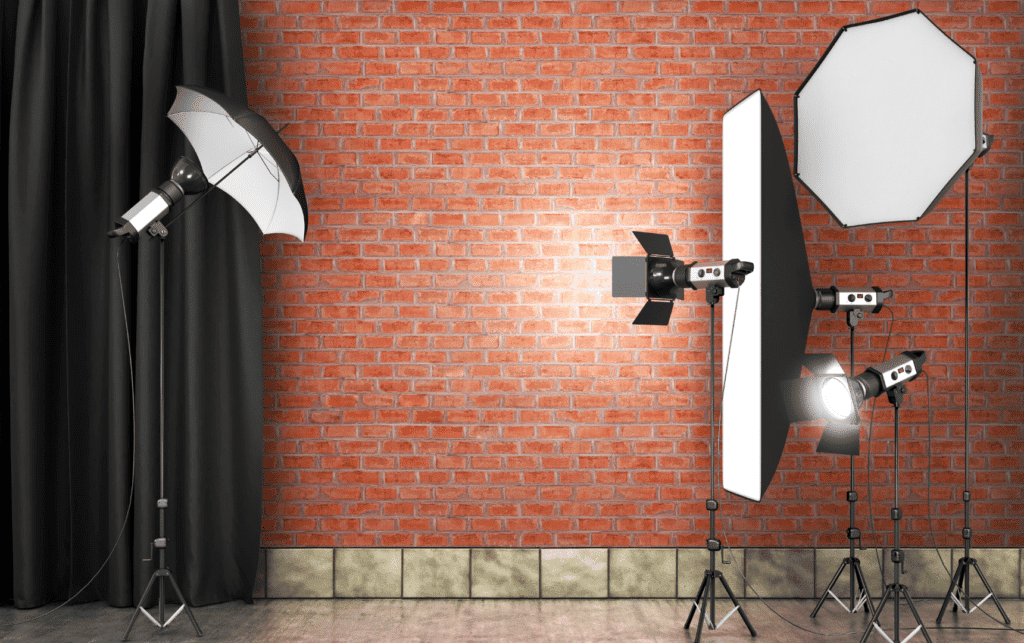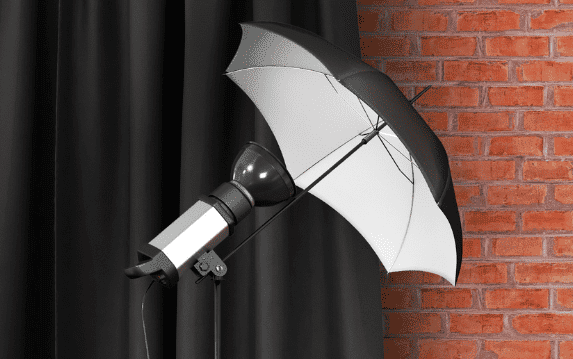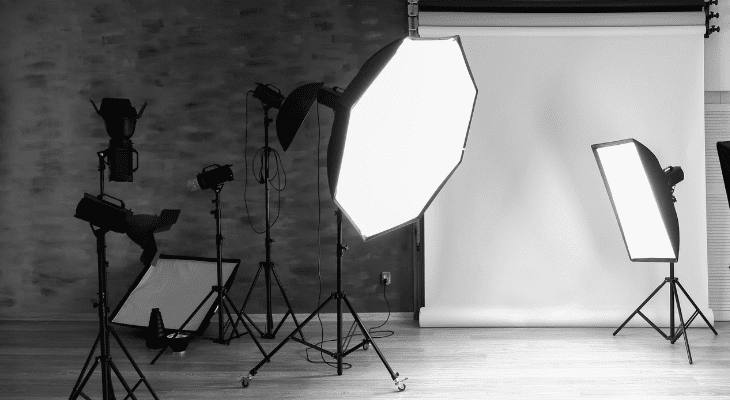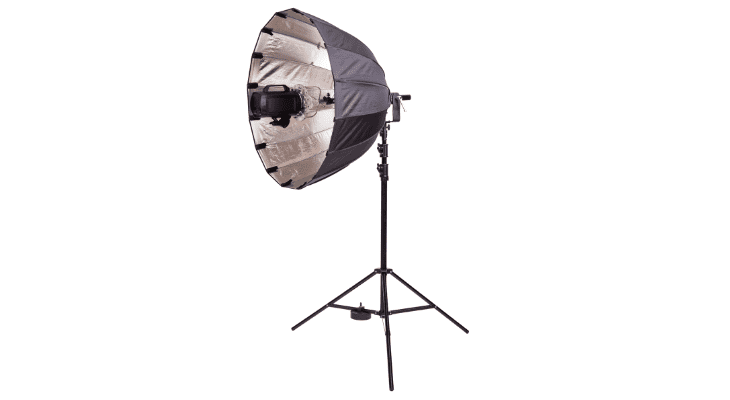You may have encountered photography umbrellas in your school or family photos, but you may not know there are a few different kinds.
4 different types of photography umbrellas explained:
- The Reflective Umbrella
- The Shoot Through Umbrella
- The Umbrella Softbox
- The Parabolic Umbrella
Let’s take a look at each of these types of photography umbrellas in more detail and discuss their main differences.

1. The Reflective Umbrella
Reflective photography umbrellas are very noticeable with their dark-colored exterior. Rather than being see-through, these umbrellas are made to catch and reflect light onto the photograph’s subject.
The light is reflected in the umbrella allowing the light to cover more area than it would with just an ordinary camera flash. This means that you can capture a larger subject a lot easier, and you don’t have to worry about the entire subject of the shot being covered with light as the umbrella is designed to help with this.
You will commonly see reflective umbrellas at family photo studios, or your school yearbook photographer may bring one along. So, the chances are that you’ve encountered one before. They are popular for these shoots because they allow for more light and warmth in photos.
These umbrellas are also good for lighting the entire shot. So, the background that was chosen for your school or family picture will be prominently displayed, whereas other umbrella types may focus more on you.
Not only do reflective photography umbrellas help the light cover more ground, but these umbrellas also help light appear softer in pictures. They are perfect for photographers who are seeking warm tones in their shots. The exact tone of the light reflected will be determined by the color choice for the umbrella’s inside.

While the reflective photography umbrella has a dark exterior made to bounce the light back on the subject, the interior of the umbrella can vary based on what you are looking for in your shot. The interior color of the umbrella can vary from gold or silver to white, and each color will affect the shot. So, it is important to know what each color does before shooting.
So, let’s talk about what each interior color does to the lighting of a picture. First, there is the gold option. Gold is commonly used for weddings and other romantic settings because it provides a warm glow to each shot. This can help each person at the wedding look like they have a healthy glow, but there can be some drawbacks.
As you may know, adding gold reflection to any picture can slightly change the color of things in the picture. So, while it is popular for weddings, there is a risk that the gold interior can change the tone of the bride’s white wedding dress. White is a blank canvas when it comes to incorporating other colors. So, a gold-tone can change the tone of a white dress.
Silver is a much more calm version of gold, and it will not affect the color of objects in your shot. Silver will still help make the quality of light stronger in your shot, but it does this without all the warm tones. Not only will this help you get a more accurately colored shot, but it will still give your shot more light.
Silver interiors are more neutral than gold, but the metallic composition of silver allows it to produce more of a dynamic color. It does this in a way that is very different from gold because it doesn’t change the shades of lighter colors like gold does. Instead, silver intensifies these colors and helps them stand out.
White is the most basic of interior photography umbrella colors. Since there are no metallic colors in white, it is the best way to achieve the most neutral color in a shot. However, the loss of metallic color when using white means that it will not reflect as strongly as the other colors. So, while you are getting more true colors throughout the picture, the picture will not be as bright or vibrant as those with gold or silver interior photography umbrellas.
Reflective umbrellas are a very popular type of photography umbrellas because they are dynamic and come with some color varies depending on what you are looking for in your shot. But it is important to understand that the different interior colors will change the picture that you get. So, make sure you get the right interior color for the result you are looking for.
2. The Shoot Through Umbrella
Shoot through umbrellas are the opposite of reflective umbrellas. Rather than having a flash of light bounce off the umbrella and back to your subject, shoot-through umbrellas are made for the flash to pass through.
They work by acting as a barrier between the flash and the subject. So, rather than facing away from the subject like reflective umbrellas, shoot through umbrellas are made to catch the light and redistribute it before it reaches the subject of your shot. So, instead of the subject looking directly at the flash, they would look at an umbrella that softens the light.
These umbrellas can be a lot closer to the subject of your shot than reflective umbrellas because the light is not bouncing back intensely. Rather it is passing through the umbrella, creating a softer light hitting your subject. This is another popular wedding choice because the umbrella will soften the light giving the people in the shot more of a soft glow.
Shoot through umbrellas are made to interrupt the light from the flash and distribute it differently. Rather than having a small area of intense light, these umbrellas halt the intensity of the flash and distribute the light throughout the umbrella, which allows it to cover more space.
One of the biggest downsides of shoot-through umbrellas is that the light is reflected so widely that it is hard to control. With reflective photography umbrellas, it is easy to move the umbrella around to control where the light shines. However, shoot through umbrellas are designed differently, making them more difficult to control.
So, when using shoot-through umbrellas, the light is more likely to reflect off of surfaces like walls which can create glares and bright spots in the shot. So, it is important to be careful when setting up your shot if you are using this type of photography umbrella. This isn’t always a downside, though.
Sometimes it is ideal to light up the background of your shot, especially if you are using shadows to your advantage. However, it may not be ideal. In this case, you can move the umbrella back further away from your subject. This will help the background be less reflective, and it will make the light softer.
Different sized umbrellas also make a huge difference with this type. Smaller shoot through umbrellas will create a smaller spread of light. So, if you are looking to cover a larger area, then you will want to find a larger shoot through umbrella to suit your needs.
Large shoot through umbrellas is great for creating the effect of more than one light source. With a large enough umbrella, light can wrap around your subject, causing it to look like there is more than one light source.
3. The Umbrella Softbox
Softboxes are a little bit different from regular photography umbrellas, but they have the same purpose. The biggest difference between a softbox and the umbrellas we talked about already is that they are more angular. Their shape allows you to better control where the light goes and helps prevent light from landing where it is not wanted
.
Rather than the round shape of an umbrella, a softbox gives you a rectangular reflection of light. This can look more natural, like light coming in from an open window or door. So, when you want to have a more natural, indoor look, softboxes can give you just that. But that’s not all they are good for.
Softboxes work similarly to reflective umbrellas where they are meant to be open toward the subject. The light will bounce off of the interior of the softbox, which will then be projected onto the subject. This also means that they have different color interiors available, similar to what we discussed above with reflective umbrellas.

The colors vary between silver and white depending on the tone you are looking for, but unlike reflective umbrellas, softboxes won’t alter the colors of subjects in your shot. So, wedding dresses will remain white with softboxes.
Softboxes come in many different shapes and sizes, which all allow for unique lighting. The best way to determine the size of the softbox that you need is that its size should be equal to the size of the subject you are shooting or at least as close as possible.
Softboxes are especially useful when it comes to shadows. Because of their shape and the quality of light produced, they tend to soften shadows. This allows for a much softer look than a reflective umbrella or even a shoot through umbrella. While shadows are fun to play with in photography, they aren’t always wanted.
For example, if you are doing shots for a wedding, a close-up shot with one of the umbrellas we discussed above could bring out a lot of unwanted shadows. For example, lines and wrinkles on the subject’s face can be dramatized with those umbrellas.
However, a softbox will give you more of a chance to hide those shadows and blur those lines because the light is reflected softer. So, you are far less likely to see those unwanted shadows from a softbox.
4. The Parabolic Umbrella
Similar to the umbrellas we discussed above, the parabolic umbrella reflects light on your subject. Parabolic umbrellas are more round in their shape and can be adjusted by the user to produce different amounts of light. This means that a parabolic umbrella can be kept at just about any position, unlike other photograph umbrellas that are simply open or closed.
Compared to other umbrellas that we have talked about, parabolic umbrellas are more dome-shaped. Rather than bouncing light around, these umbrellas are made to be more direct. They will project light on your subject but use a smaller area which creates a stronger light.
Similar to softboxes, these umbrellas are made to light a more specific area. However, they do this more accurately because of their shape. Unlike every other type that we have talked about, the light doesn’t bounce around in the parabolic umbrella. Since it is a dome shape, the light reflects off one surface and shines back on the subject.

Without the additional surfaces, this umbrella will reflect light stronger and more specific to one area. So, it is very useful for drawing attention to a specific thing in a picture. If you want a subject to stand out against the background, then try using a parabolic umbrella on the subject and allowing the background to remain unremarkable.
This is a popular choice for glamour shots on a busy street or any shot with a lot going on in the background. Because of the intensity of the parabolic umbrella light, it can be used similarly to softboxes, which means that one of these umbrellas can mimic the look of multiple light sources.
The appearance of multiple light sources may not seem like a big deal, but it really helps to minimize unwanted shadow effects. Rather than creating a harsh shadow of your subject, parabolic umbrellas create such a singular, intense light that it wraps around the subject, which eliminates the need for multiple sources.
Parabolic umbrellas are popular because they are the easiest to control. You can adjust them to just about any level of openness, which is a lot different from the umbrellas we discussed above.
When we discussed softboxes, we talked about size variation and how it can help you use light differently. These umbrellas give you that freedom without buying multiple different sizes to accommodate your needs. So, you can use one parabolic umbrella for multiple different shots with different subjects, and you’ll be able to adjust it if needed.
Sources
- B&H Photo and Electronics Corp: A Guide To Choosing Umbrellas And Softboxes
- DIY Video Studio: Different Types of Photography Umbrellas And How To Use Them
- Nikon: Controlling The Light Spilling Onto The Subject
- The Phoblographer: Tutorial: The Differences Between A Parabolic Umbrella And A Beauty Dish
Recent Posts
QuickTime is a vital app for many Mac users, and if you’ve recently bought a new microphone, you might wonder how to use it optimally. QuickTime cannot record audio content if it doesn’t have...
Every microphone leaves a unique signature on the quality of its output. If you’re a podcaster trying to melt your way into your audience’s hearts, a muddy, distorted recording won’t cut it....
